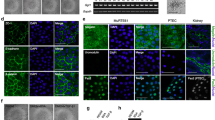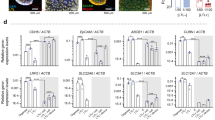Abstract
Angiotensin II is a major regulatory peptide for proximal tubule Na+ reabsorption acting through two distinct receptor subtypes: AT1 and AT2. Physiological or pathological roles of AT2 have been difficult to unravel because angiotensin II can affect Na+ transport either directly via AT2 on luminal or peritubular plasma membranes of proximal tubule cells or indirectly via the renal vasculature. Furthermore, separate systemic and intratubular renin–angiotensin systems impart considerable complexity to angiotensin’s regulation. A transport-competent, proximal tubule cell model that lacks AT2 is a potentially useful tool to assess cellular angiotensin II regulation. To this end, AT2-receptor-deficient mice were bred with an Immortomouse®, which harbors the thermolabile immortalization gene SV40 large-T antigen (Tag), and AT2-receptor-deficient [AT2 (−/−)], Tag heterozygous [Tag (+/−)] F2 offspring were selected for cell line generation. S1 proximal tubule segments were microdissected, and epithelial cell outgrowth was expanded in culture. Cells that formed confluent, electrically resistive monolayers were selected for cryopreservation, and one isolate was extensively characterized for conductance (2 mS/cm2), short-circuit current (Isc; 0.2 μA/cm2), and proximal tubule-specific \( \operatorname{Na} ^{ + }_{3} - \operatorname{succinate} \) (ΔIsc = 0.8 μA/cm2 at 2 mM succinate) and \( \operatorname{Na} ^{ + }_{3} - \operatorname{phosphate} \;cotransport \) (ΔIsc = 3 μA/cm2 at 1 mM phosphate). Light microscopy showed a uniform, cobblestone-shaped monolayer with prominent cilia and brush borders. AT2 receptor functionality, as demonstrated by angiotensin II inhibition of ANF-stimulated cGMP synthesis, was absent in AT2-deficient cells but prominent in wild-type cells. This transport competent cell line in conjunction with corresponding wild type and AT1-deficient lines should help explain angiotensin II signaling relevant to Na+ transport.





Similar content being viewed by others
References
Baum, M.; Quigley, R. Maturation of rat proximal tubule chloride permeability. Am J Physiol Regul Integr Comp Physiol 289:R1659–R1664; 2005.
Baum, M.; Toto, R. D. Lack of a direct effect of atrial natriuretic factor in the rabbit proximal tubule. Am J Physiol 250:F66–F69; 1986.
Beltowski, J; Wojcicka, G. Regulation of renal tubular sodium transport by cardiac natriuretic peptides: two decades of research. Med Sci Monit 8:RA39–RA52; 2002.
Berry, C. A. Lack of effect of peritubular protein on passive NaCl transport in the rabbit proximal tubule. J Clin Invest 71:268–281; 1983.
Berry, C. A.; Rector, Jr., F. C. Renal transport of glucose, amino acids, sodium, chloride, and water. In: Brenner, B. M. and Rector, Jr., F. C. (eds), The Kidney. Saunders, Philadelphia, pp. 245–282; 1991.
Carey, R. M. Cardiovascular and renal regulation by the angiotensin type 2 receptor. The AT2 receptor comes of age. Hypertension 45:840–844; 2005.
Charloux, A.; Piquard, F.; Doutreleau, S.; Brandenberger, G.; Geny, B. Mechanisms of renal hyporesponsiveness to ANP in heart failure. Eur J Clin Invest 33:769–778; 2003.
Chen, Z.-J.; Vetter, M.; Chang, G.-D.; Liu, S.; Che, D.; Ding, Y.; Kim, S. S.; Chang, C.-H. Cyclophilin A functions as an endogenous inhibitor for membrane-bound guanylate cyclase-A. Hypertension 44:963–968; 2004.
Crowley, S. D.; Gurley, S. B.; Oliverio, M. I.; Pazmino, A. K.; Griffiths, R.; Flannery, P. J.; Spurney, R. F.; Kim, H. S.; Smithies, O.; Le, T. H.; Coffman, T. M. Distinct roles for the kidney and systemic tissues in blood pressure regulation by the renin-angiotensin system. J Clin Invest 115:1092–1099; 2005.
Donnelly, S. Why is erythropoietin made in the kidney? The kidney functions as a ‘critmeter’ to regulate the hematocrit. Adv Exp Med Biol 543:73–87; 2003.
Eitle, E.; Hiranyachattada, S.; Wang, H.; Harris, P. J. Inhibition of proximal tubular fluid absorption by nitric oxide and atrial natriuretic peptide in rat kidney. Am J Physiol Cell Physiol 274:C1075–C1080; 1998.
Garcia, N. H.; Garvin, J. L. ANF and angiotensin II interact via kinases in the proximal straight tubule. Am J Physiol Renal Physiol 268:F730–F735; 1995.
Haas, J. A.; Knox, F. G. Effect of synthetic atrial natriuretic peptide on superficial and deep proximal tubule sodium reabsorption. J Lab Clin Med 113:458–462; 1989.
Hakam, A. C.; Hussain, T. Angiotensin II type 2 receptor agonist directly inhibits proximal tubule sodium pump activity in obese but not in lean Zucker rats. Hypertension 47:1117–1124; 2006.
Hakam, A. C.; Siddiqui, A. H.; Hussain, T. Renal angiotensin II AT2 receptors promote natriuresis in streptozotocin-induced diabetic rats. Am J Physiol Renal Physiol 290:F503–F508; 2006.
He, W.; Miao, F. J.; Lin, D. C.; Schwandner, R. T.; Wang, Z.; Gao, J.; Chen, J. L.; Tian, H.; Ling, L. Citric acid cycle intermediates as ligands for orphan G-protein-coupled receptors. Nature 429:188–93; 2004.
Ichiki, T.; Labosky, P. A.; Shiota, C.; Okuyama, S.; Imagawa, Y.; Fogo, A.; Nilmura, F.; Ichikawa, I.; Hogan, B. L. M.; Inagami, T. Effects on blood pressure and exploratory behavior of mice. Nature 377:748–750; 1995.
Kobori, H.; Ozawa, Y.; Suzaki, Y.; Prieto-Carrasquero, M. C.; Nishiyama, A.; Shoji, T.; Cohen, E. P.; Navar, L. G. Young Scholars Award Lecture: Intratubular angiotensinogen in hypertension and kidney diseases. Am J Hypertens 19:541–550; 2006.
Kolb, R. J.; Woost, P. G.; Hopfer, U. Membrane trafficking of angiotensin receptor type-1 and mechanochemical signal transduction in proximal tubule cells. Hypertension 44:352–359; 2004.
Kurdi, M.; De Mello, W. C.; Booz, G. W. Working outside the system: an update on the unconventional behavior of the renin–angiotensin system components. Int J Biochem Cell Biol 37:1357–1367; 2005.
Liu, K. L.; Lo, M.; Benzoni, D.; Sassard, J. Function of renal angiotensin AT2 receptors is not enhanced in Lyon hypertensive rats. Clin Exp Pharmacol Physiol 30:413–418; 2000.
Murer, H.; Hernando, N.; Forster, I.; Biber J. Proximal tubular phosphate reabsorption: molecular mechanisms. Physiol Rev 80:1373–1409; 2000.
Pajor, A. M. Molecular properties of sodium/dicarboxylate cotransporters. J Membrane Biol 175:1–8; 2000.
Palmer, L. G.; Sackin, H. Electrophysiological analysis of transepithelial transport. In: Seldin, D. W. and Giebisch, G. (eds), The Kidney: Physiology and Pathophysiology. Vol. 1. Raven Press, New York, pp. 361–405; 1992.
National Institutes of Health. Public Health Service Policy on Humane Care and Use of Laboratory Animals. Office of Laboratory Animal Welfare, National Institutes of Health, Bethesda, MD; 2001.
Quan, A.; Baum, M. Endogenous production of angiotensin II modulates rat proximal tubule transport. J Clin Invest 97:2878–2882; 1996.
Quan, A.; Baum, M. Effect of luminal angiotensin II receptor antagonists on proximal tubule transport. Am J Hypertens 12:499–503; 1999.
Radisky, D. C.; Levy, D. D.; Littlepage, L. E.; Liu, H.; Nelson, C. M.; Fata, J. E.; Leake, D.; Godden, E. L.; Albertson, D. G.; Nieto, M. A.; Werb, Z.; Bissell, M. J. Rac1b and reactive oxygen species mediate MMP-3-induced EMT and genomic instability. Nature 436:123–127; 2005.
Siragy, H. M.; Inagami, T.; Ichiki, T.; Carey, R. M. Sustained hypersensitivity to angiotensin II and its mechanism in mice lacking the subtype-2 (AT2) angiotensin receptor. Proc Natl Acad Sci U S A 96:6506–6510; 1999.
Stevens, K. M. Oxygen requirements for liver cells in vitro. Nature 206:199; 1965.
Suliman, H. B.; Ali, M.; Piantadosi, C. A. Superoxide dismutase-3 promotes full expression of the EPO response to hypoxia. Blood 104:43–50; 2004.
Todd, J. H.; Sens, M. A.; Hazen-Martin, D. J.; Bylander, J. E.; Smyth, B. J.; Sens, D. A. Variation in the electrical properties of cultured human proximal tubule cells. In Vitro Cell Dev Biol Anim 29A:371–378; 1993.
Wolf, G.; Wenzel, U.; Burns, K. D.; Harris, R. C.; Stahl, R. A.; Thaiss, F. Angiotensin II activates nuclear transcription factor-kappaB through AT1 and AT2 receptors. Kidney Int 61:1986–1995; 2002.
Woost, P. G.; Kolb, R. J.; Finesilver, M.; Mackraj, I.; Coffman, T. M.; Hopfer, U. Strategy for the development of a matched set of transport-competent, angiotensin receptor-deficient proximal tubule cell lines. In Vitro Cell Dev Biol Anim 42:189–200; 2006.
Zelko, I. N.; Folz, R. J. Extracellular superoxide dismutase functions as a major repressor of hypoxia-induced erythropoietin gene expression. Endocrinology 146:332–340; 2005.
Acknowledgments
The full-length cDNA for SV40 large T-antigen was generously supplied by Dr. James W. Jacobberger’s laboratory, Case Western Reserve University, Cleveland, OH. This work was supported, in part, by National Institutes of Health grants DK-027651, HL-41618, and P30CA43703-12. RJK was supported by National Institutes of Health grant DK-07678.
Author information
Authors and Affiliations
Corresponding author
Additional information
Editor: J. Denry Sato
Rights and permissions
About this article
Cite this article
Woost, P.G., Kolb, R.J., Chang, CH. et al. Development of an AT2-deficient proximal tubule cell line for transport studies. In Vitro Cell.Dev.Biol.-Animal 43, 352–360 (2007). https://doi.org/10.1007/s11626-007-9061-1
Received:
Accepted:
Published:
Issue Date:
DOI: https://doi.org/10.1007/s11626-007-9061-1




